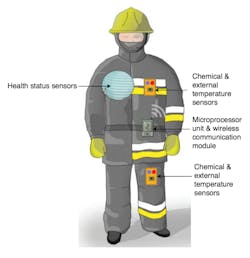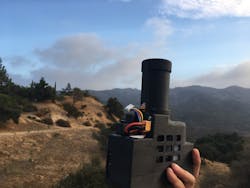Fire Technology: The Future of Wearable Technology
Since 2004, the National Fallen Firefighters Foundation (NFFF) has partnered with organizations that are advancing firefighter safety and survivability—and its latest venture is no different.
In March, the NFFF hosted the Firefighter Physiological Monitoring Technology Summit, in collaboration with Skidmore College’s SMARTER program, to reduce line-of-duty deaths (LODDs) through the application of science, medicine and technology. During the Summit, several speakers presented information on the emerging field of firefighter wearable technology, specifically three areas of interest:
1. The use of wearable electrocardiogram (ECG) technology to detect early signs of cardiac events following firefighting or training exercises;
2. The use of algorithms to estimate core temperature to reduce the risk of heat-related injuries and fatalities;
3. The use of low-cost, portable technology to monitor air contamination levels on the fireground and in structures post-fire.
The ultimate goal will be to use this data to provide near-real-time information to the incident commander (IC), who can then make critical decisions about the safety of their members operating on the scene.
Physiological monitoring
At the NFFF Firefighter Physiological Monitoring Technology Summit, Casey Grant—executive director of the Fire Protection Research Foundation, the research affiliate of the National Fire Protection Association (NFPA)—spoke on the future of wearable technology. Wearable technology is any type of technology that can be worn or built into present uniforms and/or protective clothing for the purpose of collecting data that can be transmitted and monitored that will provide useful information that will enhance firefighter safety. This technology could include physiological monitoring, sensing of gases, location of firefighters, personal alert safety system, etc.
Grant’s presentation highlighted the ongoing work between NFPA and the National Institute of Standards & Technology (NIST), which together published the report “Research Roadmap for Smarter Firefighting” (https://nvlpubs.nist.gov/nistpubs/SpecialPublications/NIST.SP.1191.pdf).
The collection and dissemination of data collected from wearable technology is achieved through a cyber-physical system (CPS), which is essentially integrations of computation, networking and physical processes. More simply stated, this is about harvesting data to be used as information knowledge to make better decisions. In the technology world, this framework is known as the DIKW pyramid or hierarchy. This takes data through a transformational evolution from data (D) to information (I) to knowledge (K), ultimately resulting in wisdom (W). This is the same process that data giants like Google and Amazon are using to better understand how individuals make purchases, travel and other personal behavior/preferences.
While this process seems a bit complex, in the CPS environment, it is narrowed into three basic steps: 1) collect the data, 2) process the data and 3) deliver the data. Collecting the data is fairly straightforward. Processing the data is a little more complicated, as it will often require the use of algorithms to produce usable information. Delivering the data provides a targeted delivery of information/knowledge to its intended recipient(s). Critical to this last step is the specific information (nothing more) in the format needed, delivered to the recipient(s) in near real-time to specific devices.
In the fire service, an example would be biometric monitoring of the physiological state of a firefighter. Collection of data would include capturing heart rate, respiration rate, body temperature and an electrocardiogram (ECG) from body-worn sensors. The processing would use algorithms to determine and alert if these rates are determined to be at a dangerous level, either singularly or in combination. The information would then need to be delivered in the format needed to a device. The process step helps to limit the information sent so as not to be overwhelming to the IC or the IC’s staff.
During the Summit, Grant shared the Hanover Park, IL, Fire Department as an example of one of the leading departments actively testing physiological monitoring of firefighters during the rehab phase of an incident. It was decided to conduct testing at this stage of an incident because it is a controlled, non-hazardous environment. As the results of the rehab testing were revealed, it was quickly realized that the firefighters were not recovering to their normal resting state in the time as originally thought necessary.
Another forward-thinking department is the Houston Fire Department (HFD), which is conducting tests during training sessions. The HFD had an LODD during training, and its efforts are focused at early identification of physiological issues to prevent LODD during training.
Physiological monitoring of firefighters on the fireground is more complicated. This is an uncontrolled environment with hazardous conditions of heat, smoke, water and toxicity. This requires a great deal of research to form fit, ease of operation, durability, intrinsically safe and seamless donning so as not to add to the time of firefighter preparation and turnout. Future success of physiological monitoring will require a combined effort to develop these algorithms for firefighter monitoring. The good news is that some of the data/software giant tech companies in Palo Alto, CA, are interested in helping with the development of such algorithms.
Grant also pointed out that while it is clear that the technology exists to advance firefighter physiological monitoring, the larger challenges are not with technology; they are with legal issues, workplace impacts, privacy, data rules, political, operational impacts, data storage, cultures and sub-cultures. One looming policy question is, “How will this monitoring impact my career as a firefighter?” This will have to be clearly explained in a way that will result in better firefighter safety and reduced LODDs, and in a way that is accepted by the fire service community and demonstrates the “what’s in it for me?” and “what’s in it for we?” mentality.
Additional operational challenges are also apparent, such as the policies and procedures, staffing necessary to monitor, and technology cost/support/maintenance. A big “what if” that stands out is what if the physiological monitoring equipment is not working when a firefighter is about to enter a hazardous environment? What if the same equipment is not working on a group of firefighters or connectivity issues or interference prevent the monitoring equipment from working? Will these circumstances then prevent their entry into a dangerous atmosphere?
Particulate monitoring
During the Summit, Dr. Aydogan Ozcan, the Chancellor’s Professor at UCLA, tackled the topic of an accurate and inexpensive wearable device to monitor and identify particulates and sub-particulates at the sub-micron level (invisible to the naked eye).
An important and unexpected discovery from Dr. Ozcan’s research at UCLA is that during a fire the physical structure of these particulates change. As some of these particulates morph, some also begin to elongate. The size of the particulate and elongation is important, as particulates that are 2.5 microns (three times smaller than a red blood cell) or smaller have been identified as carcinogens (cancer-causing agents) when they enter and circulate through the body through inhalation or absorption.
These particulates also morph at different stages of a fire and as they travel from a fire to outlying areas. During a wildfire near UCLA in 2016, particulates from that fire were measured as far as 40 kilometers away. To date, there is a very little known about how far the particulates travel and remain harmful. This will be important to understand and perhaps redefine hot and warm zones at incidents.
While monitoring is now being done during the overhaul phase of firefighting for gases, the UCLA research results suggest that particulate testing and analysis must be done in additional areas and throughout the firefighting operation. Dr. Ozcan also advised that this type of monitoring must be ongoing, as cumulative exposure to these particulates over years may be a significant cause of cancer and other firefighter health issues. Note: This does NOT change the need for the present gas monitoring procedures but is offered as an additional enhancement.
The prototype particulate-monitoring device (c-AIR) that Dr. Ozcan presented is slightly larger than an iPhone and is currently not designed to be intrinsically safe. However, he says that with additional design tweaks, this technology can be miniaturized and even be added to existing multi-gas detectors. In the future, Dr. Ozcan believes that particulate monitoring may be able to identify heat signatures of different fire types and the complexities associated with each. This will also include how these particulates morph at various stages of the fire.
Dr. Ozcan believes that the future and success of this technology will require a design that focuses on ease of use, is more robust for firefighting, and is smaller and meets form-factor requirements. As this technology continues to improve, there is a critical need for continued research to better understand particulate morphology, travel distances and impact on the human body.
Communications and other wearable technology
To support the transmission of critical physiological data, through the creation of a nationwide public safety broadband network, FirstNet has and will continue to enhance communications technology in the area of wearable technology. This nationwide network will provide priority and preemption, which will inevitably enable all of the physiological monitoring and a lot more. This will enable remote sensing of all types, such as hazmat gases, radiological, biohazards and more. Technology such as NextNav’s Metropolitan Beacon System (MBS) have proven that firefighter location inside a building can be achieved and monitored to include not only the X and Y coordinates but also the Z (height/floor level). Knowing the location of a firefighter in distress or mayday situation is the single most important information to the IC.
In the past several weeks, MIT announced that it has developed a wearable technology that can “hear the words” you say in your head. The technology attaches to the face of a person and is able to interpret subvocalization (like when you read to yourself) and uses artificial intelligence (AI) to create an intelligent augmented device. Technologies like Google Glass, a type of smart glasses that displayed information in a smartphone format and interactive through voice commands, offer promise in the fire and EMS world. Further, NIST Public Safety Communications Research (PSCR) Labs in Boulder, CO, are presently exploring virtual reality (VR) and augmented reality (AR) wearable technology in the areas of simulation and training.
What’s ahead
The future of monitoring technology, wearables and other communications technology is very promising. Make no mistake, there are significant challenges, such as interoperability between systems, connectivity while operating in large buildings or in sub-basement areas, among other challenges. Another challenge is that technology continues to evolve and outpace the development of standards. Regardless of the challenges, once the value is clear that this wearable technology will reduce the harmful effects on a firefighter’s health, reduce firefighter LODDs and enhance effectiveness, those challenges WILL BE OVERCOME!
To learn more about the Firefighter Physiological Monitoring Technology Summit, as well as the NFFF and how you can support its efforts, visit http://firehero.org.
About the Author

Charles Werner
CHARLES WERNER, who is a Firehouse contributing editor, is a 45-year veteran of public safety. He served with the Charlottesville, VA, Fire Department for 37 years, serving the past 10 years as chief. Following retirement, Werner served for two years as senior adviser and acting deputy state coordinator for the Virginia Department of Emergency Management. He has chaired: DHS SAFECOM Executive Committee; IAFC Technology Council; National Information Sharing Consortium; and DHS/White House Incident Management Information Sharing SubCommittee. Werner currently serves as the director of DroneResponders Public Safety Alliance, chair of the National Council on Public Safety UAS and chair of the Virginia Secure Commonwealth UAS Sub Panel.

